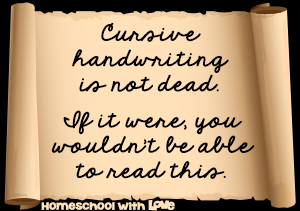
Some public schools around the United States are taking cursive handwriting out of their learning day.
I personally think this is a mistake.
There are far too many benefits that go with the learning of cursive, not to mention some practical reasons why it is useful.
I know that some people believe that technology is making handwriting into an archaic skill. That’s not necessarily true.
I’m a geek and I love technology, but that doesn’t mean I’m going to be throwing my pencils and paper away anytime soon. Sometimes I find it far more convenient and faster to jot a note down on paper than to try and type it on my smartphone or go to my computer to put it in Evernote.
I think this whole idea of dropping cursive from schools is yet another trend sweeping our educational system, the result of which will be a whole generation of children who can’t read or write cursive, and that will be a loss.
As you’ll discover in a moment, cursive is NOT dead, not by a long shot. It actually has some practical, real-world applications as well as some benefits for your child’s brain.
Why Cursive Handwriting is Still Alive
- Everyone needs to know cursive in order to read some historical documents. Old papers such as the Declaration of Independence and the US Constitution were written by our founding fathers in cursive. We shouldn’t have to “translate” these into print in order for our children to read them. Quite the contrary, allowing children read these in their original form is more interesting and connects children with their past.
- Cursive signatures are required today on important documents. Items such as checks, credit cards, and legal papers need a person’s genuine, handwritten (in cursive) John Hancock.
- It’s faster to write in cursive than print. When you write using print, you have to stop and start to make the strokes for each letter. With cursive, the flow of writing is much smoother and connected so you can do it more quickly.
- It’s required on the PSAT and SAT tests. Students must write a statement in cursive indicating that they who they say they are. Plus, the College Board discovered that students who wrote the essay portion of the test in cursive scored a bit higher than those who used print.
- Learning cursive is important for cognitive development. According to this article in Psychology Today, it can help children improve the functions of certain areas of the brain.
- Handwriting activates multiple areas of the brain in both the right and left hemispheres. Virginia Berninger, Professor of Educational Psychology, discovered through brain scans that many regions of the brain including those involved in language and working memory were active while handwriting.
- Cursive handwriting can help children discern between b’s and d’s. With print, these two letters can appear very similar to young learners. However, with cursive, a b begins with a large upward curve to the right like a cursive l, and a d begins with a small curve to the left like a cursive a. Children can easily perceive these differences and carry this knowledge over to reading.
- Cursive handwriting activates areas of the brain that typing on a keyboard does not. For that reason, it can improve cognitive abilities in ways that keyboarding cannot.
- It improves fine motor skills. Using cursive requires the child to practice good hand-eye coordination.
- Cursive handwriting is beautiful. It is aesthetically pleasing. When done very well, cursive almost looks like a work of art.
I don’t know about you, but I don’t think that cursive handwriting will become extinct anytime soon, but that’s just my opinion.
What are your thoughts on teaching cursive to your children? I’d love to hear about them in the comment section below.






